Thessaloniki’s Long-Awaited Transformation Takes Shape
From major infrastructure projects to a...
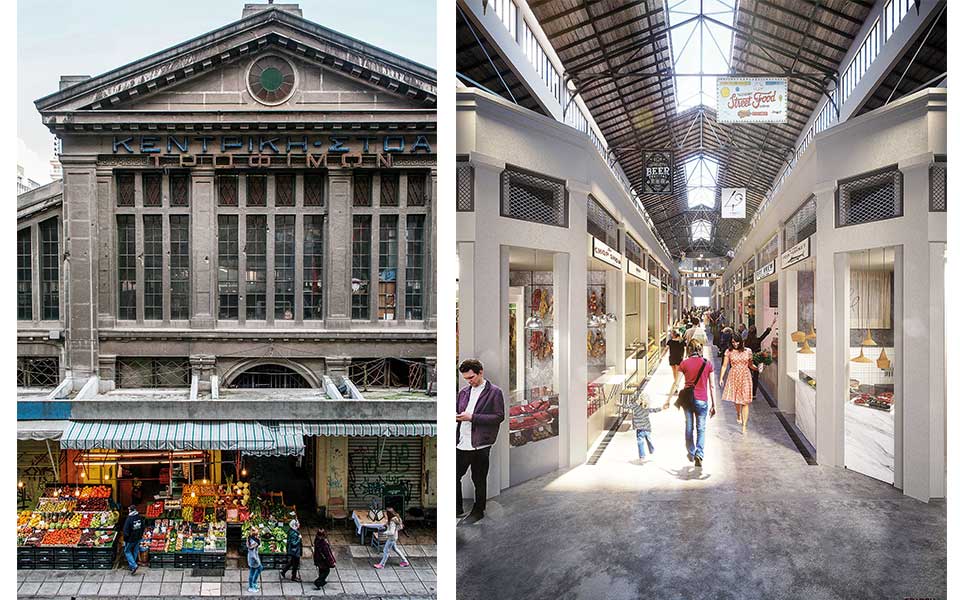
Left: Neoclassical pediments adorn the facade of the Modiano
Market where a sign reads “Central Food Arcade”.
Right: The overall structure of the building will remain the same. Plans foresee 127 commercial spaces (with the possibility
of joining two spaces into one), as well as eight establishments serving food and drinks.
© Alexandros Avramidis
The countdown has started for the Modiano Market’s transition to the modern era; downtown Thessaloniki’s main food market is expected to reopen, sparkling and refreshed, in 18 months or so. The city’s beloved arcade will be coming back to life filled with the colors and aromas of fresh Greek produce, artisanal products, traditional delights and gourmet delicacies, while cafés, restaurants, bars and other venues will vie for shoppers’ custom.
Following a delay caused by the COVID lockdowns, construction crews have been hard at work since September on the radical revamp of what is an important city landmark. With its architecture and identity as a market protected by law (in 1983 by the Ministry of Northern Greece and in 1995 by the Ministry of Culture), Modiano must continue to operate as a food emporium, though functional and aesthetic elements are being improved and historical features highlighted.
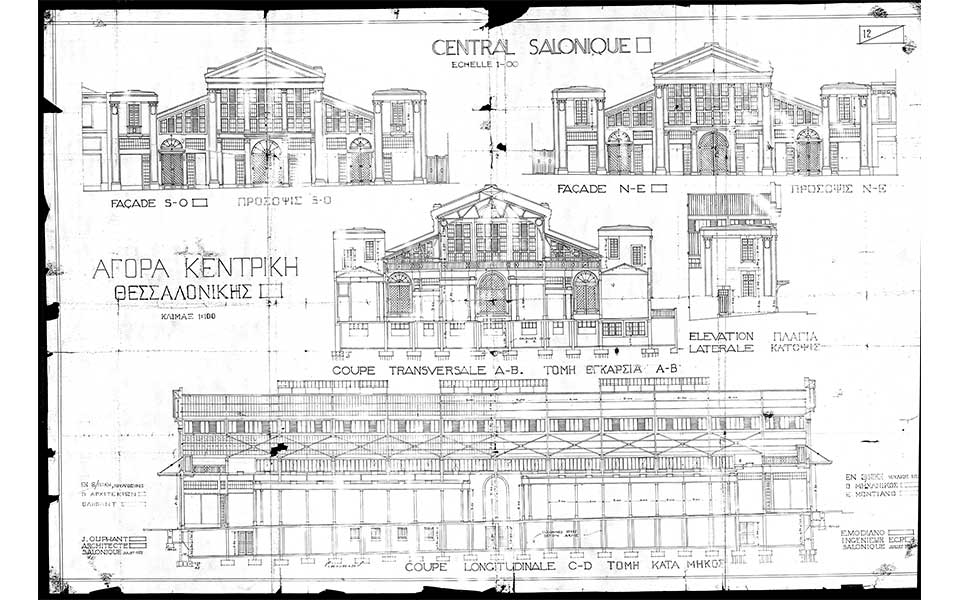
The original plans for the city’s first covered market.
© Jewish Museum Archive
The interventions on the timeworn structure are designed to bring out the “modern” identity envisioned by urban planner Ernest Hébrard a century ago when, as he redesigned the city center in the wake of the devastating 1917 fire, he zoned the city block where the Modiano would be built as a luxury shopping district. And Thessaloniki’s first indoor food market, built to European standards, was unique not just for the high quality products that could be found here, but also for its pioneering architecture.
Designed by Eli Modiano – son of banker Saul Modiano – it embodied a spirit of innovation. An architect and civil engineer with a degree from Paris’ distinguished École Centrale, Eli Modiano employed a combination of materials (stone, bricks, steel, wood) and methods to create – at a time when concrete was a new import – a mixed-material structure, designed in cooperation with William J. Oliphant.
This was among the first buildings in Greece made with reinforced concrete and other imported materials. The steel used to make the impressive roof – which is covered in glass and tiles – came from Belgium.
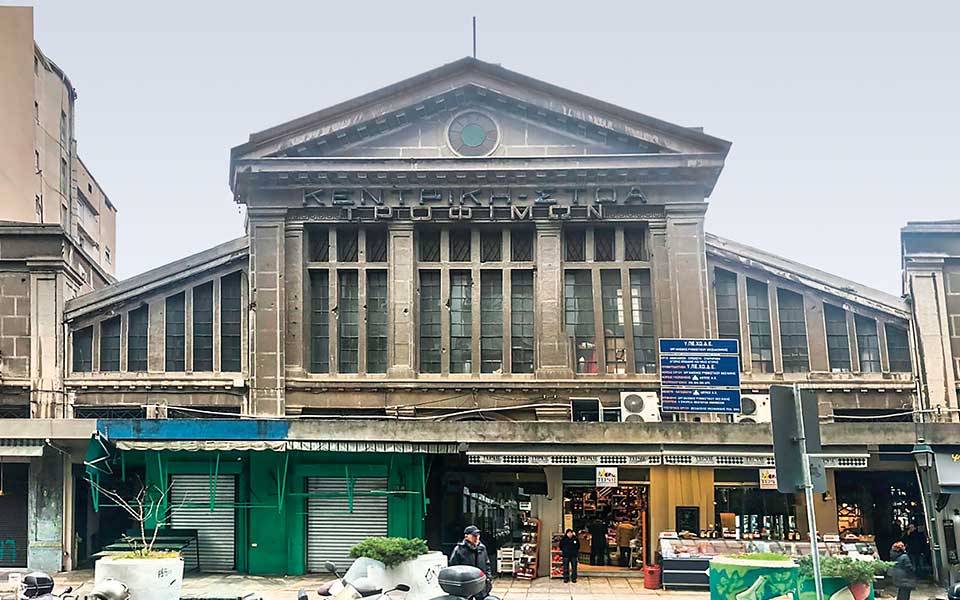
The market after a century of continuous operation.
From the time the construction permit was issued, the Modiano Market took two years to build. At the grand opening on March 23, 1925, French champagne and wine, and locally produced raki and beer accompanied an array of delicacies (including cured fish and meat, pickles and braised eggs) that were on sale at the market, which became an instant hit with the local population.
If the first covered market in Thessaloniki signaled the passage from the bazaars of the East to a Western consumer model and from traditional architecture to modern construction, the present renovation will take Modiano firmly into the 21st century.
The challenging project is a collective effort involving many parties and organizations, from the Ministry of Culture and the owners to the special advisors and surveyors who joined forces to design a modern food hall that nonetheless upholds the principles protecting the country’s historical monuments and cultural legacy.
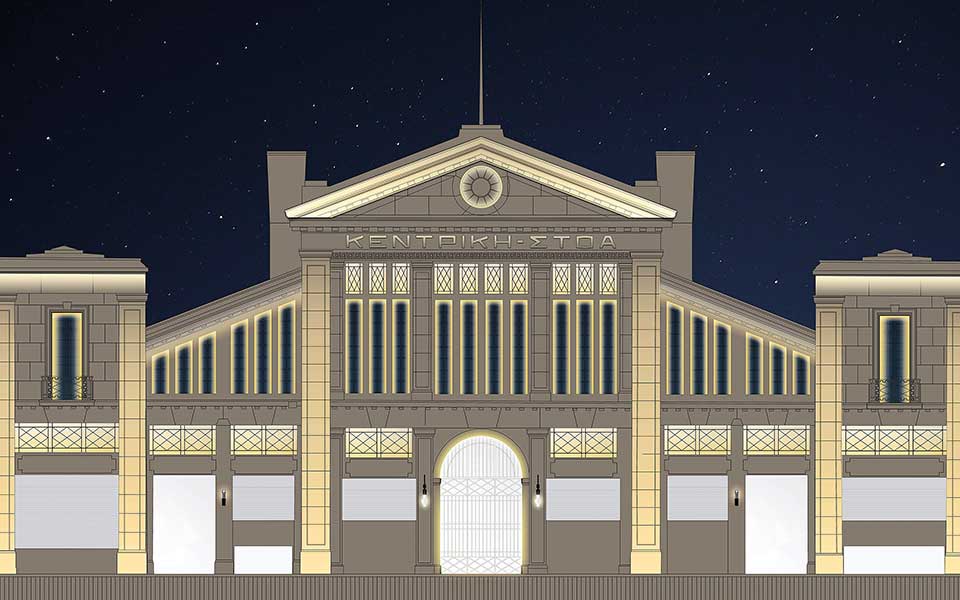
A rendering of the new lighting plans, the work of Eleftheria Deko.
The wear and tear on the building from the lack of maintenance, illegal constructions, use of water and salt at the fish market and its constant operation over about a century was considerable. The architects had to meet many challenges associated with preserving a heritage building, chief among them being ensuring the building’s stability.
Athanasios Kontizas, a civil engineer and specialist in this field, took on the task. The objective, according to project director Dimitris Triantos, was to ensure the longevity of the works, “at least for the next 100 years”.
Every step of the project had to be planned and carried out meticulously. “The chief priority is to maintain as much of the original building as possible, as well as its appearance, which – aside from its architectural structure, form and minimal adornment – is characterized by a system that is impressive for its time,” say the authors of the architectural study, Rena Sakellaridou and Morpho Papanikolaou of the firm Sparch, who were advised by architectural restoration specialist Cleopatra Theologidou.
The new market must implement the appropriate technologies to meet current safety and hygiene standards (a study was carried out by the firm of Samaras & Associates), while reflecting “the demands of modern business and the city’s cultural dynamic and its ambitions for the market’s use,” says Papanikolaou.
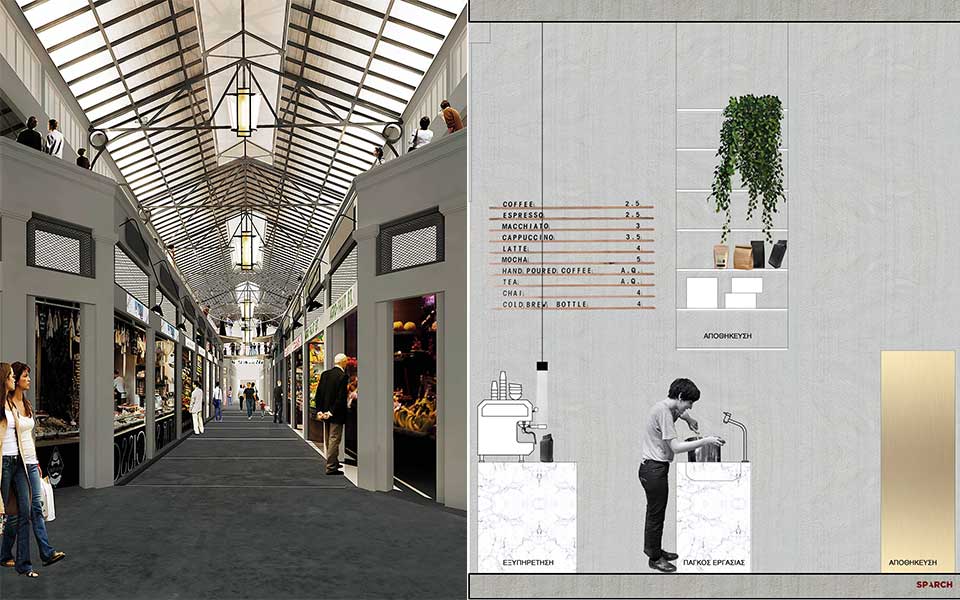
The basilica-style building is perfectly symmetrical and has a total surface area of 2,712 square meters, comprising basement areas, a ground floor and balconies. Neoclassical pediments adorn the two main entrances that join Ermou and Vasileos Irakleiou streets.
Nothing about the inside of the market will resemble the chaos of past decades; gone will be the incredible din and the impromptu parties sparked by roving musicians. The timeworn signs of the fishmongers, delis, butchers and greengrocers have come down, makeshift structures have been cleared and the building is gradually returning to its original graceful form.
The new market will have two distinct zones: the shops in dense but uncluttered rows, and, above the shops, a free, open, basically empty space dominated by the roof which – thanks to the peripheral skylights – appears to be suspended in midair. Two-story towers at the four corners of the market will house stairs leading to the upper level. Long windows beneath the eaves on the two narrowest ends will provide more natural light.
All of the surviving architectural and decorative elements will be restored and showcased. The upper-level balcony, with a large opening in the middle looking down on the ground floor, will be designed to host events and leisure activities, giving yet more life to the building and bolstering its public role.
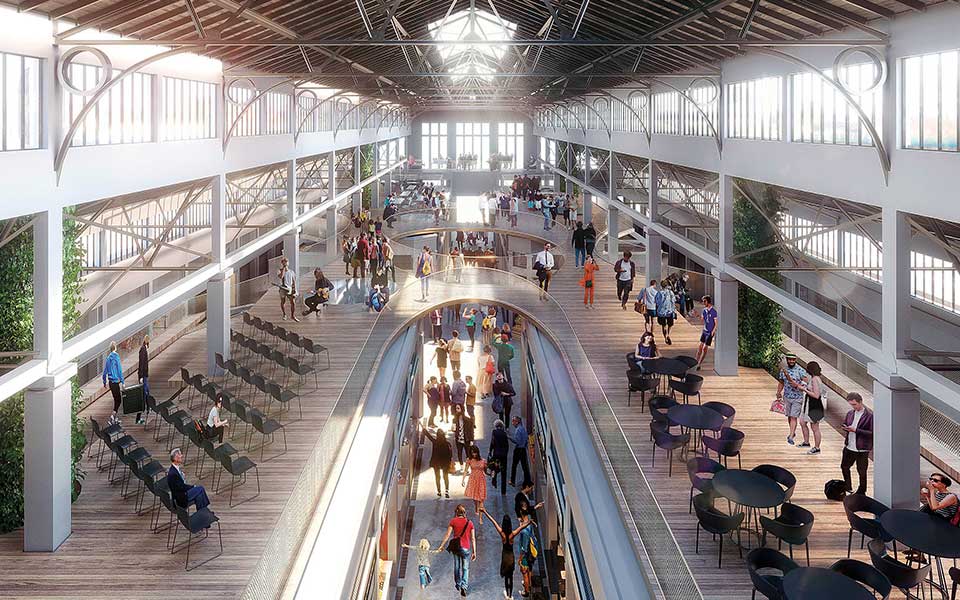
What one of the spaces in the Modiano Market might look like when the renovation is complete.
The basic idea behind the architectural approach was to highlight “the building’s dual identity as monument/market through [an acknowledgement of] the history of its construction and use. Balancing contrasts was our guiding principle,” notes Papanikolaou.
In its new form, the arcade will symbolize the harmonious coexistence of past with present, oriental exoticism with occidental austerity, tradition with modernity and the building’s autonomy with its intrinsic place in its urban surroundings. The ultimate aim is for the Modiano Market to become once again the popular and attractive destination it was in the past.
The building’s basic structure is being kept the same; ministerial decisions governing its operation foresee a maximum of 127 shop spaces, with the possibility of two being merged into one, as well as the presence of eight restaurants, cafés or bars.
According to Hasdai Capon, general manager of the FAIS Group, which has the commercial rights to the property and a 57 percent stake in its ownership, the idea of restoring the Modiano Market first came up around five years ago.
“Inspired by the Madrid food market, we chose to risk investing in modernizing and reopening [the Modiano], according to the rules governing the food markets in major cities, and not just in Europe. Swept by decline, our market had lost its dynamism and vibrancy. Our objective was not only to restore it to its former grandeur, but also to make it an attraction for Thessalonian consumers and the many, many tourists visiting the city.
“The Modiano will claim a spot on Thessaloniki’s map as a tourist attraction, where visitors can acquaint themselves with and purchase and enjoy traditional products. It will also become a destination for a day out of leisure and relaxation, right in the middle of the historic center. To this end, it will be open seven days a week, so as to fill the vacuum tourists find on Sundays and public holidays when regular retail stores are closed,” says Capon.
The aim is to make the Modiano the great city landmark it once was. The careful designs for its restoration, the lighting by Eleftheria Deko, its location near bustling shopping streets (Vlali, Vatikioti), the vibrancy of the historic center, and the changing shopping habits of the public already point to success.
This article first appeared in the print issue Greece Is Thessaloniki 2020 with the title “The Modiano Market: A New Lease on Life”. The magazine, along with other past issues, is available for order at our eshop.
From major infrastructure projects to a...
In a land where the past...
Major infrastructure projects, a significant urban...
The West Wall Collective revitalizes Thessaloniki’s...